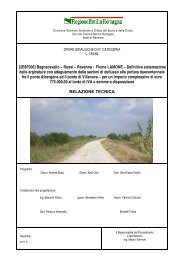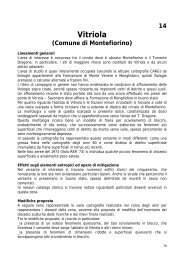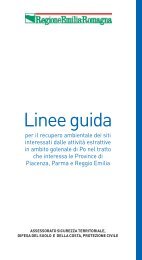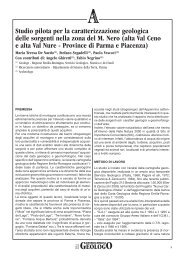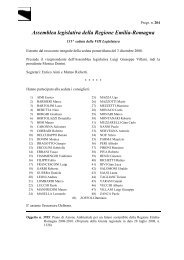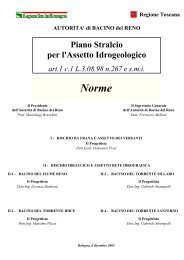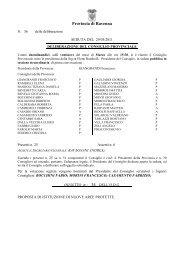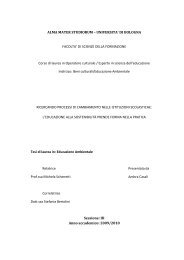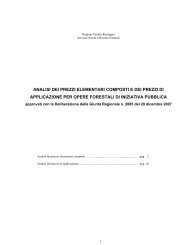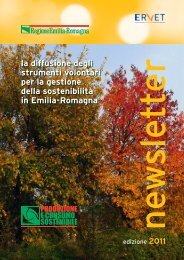air, water and soil quality qualité - ER Ambiente - Regione Emilia ...
air, water and soil quality qualité - ER Ambiente - Regione Emilia ...
air, water and soil quality qualité - ER Ambiente - Regione Emilia ...
Create successful ePaper yourself
Turn your PDF publications into a flip-book with our unique Google optimized e-Paper software.
evaluation: if finished, it could perhaps have solved the Aral Sea Crisis, but in the<br />
meantime it would certainly have triggered a new ecological crisis in the Siberian<br />
taiga biome (Micklin, 1987a; Micklin, Bond, 1988). Thanks to the opposition of a<br />
part of Soviet scientific community (Darst, 1988), <strong>and</strong> under the influence of new<br />
Soviet Leader Gorbachev’s Perestroika <strong>and</strong> Glasnost, in 1986 “The Project of the<br />
Century” was officially stopped (Micklin, 1987b).<br />
Around the middle of ’90s, several years after the USSR disgregation, Karimov<br />
<strong>and</strong> Nazarbayev, Uzbekistan <strong>and</strong> Kazakhstan Presidents respectively, exhumed the<br />
Siberian rivers diversion project to fill up the newly born Large Aral Sea, reproposing<br />
it to Russia. This state, even though it emphasizes the high costs <strong>and</strong> the<br />
environmental impact of such a work, assuming an ambiguous position until today<br />
has not rejected the program, perhaps with the aim, in the near future, to keep<br />
influence <strong>and</strong> political pressure towards Uzbekistan <strong>and</strong> Kazakhstan (International<br />
Crisis Group, 2002).<br />
At now, Central Asian economical <strong>and</strong> geopolitical situation persuaded most of the<br />
scholars to consider an Utopia the restoration of the Aral Sea in conformity with<br />
the originary level. If Small Aral Sea does not present alarming criticity <strong>and</strong> it<br />
appears addressed to <strong>water</strong> resources sustainability, the efforts, both theorical <strong>and</strong><br />
practical, are now devoted to the Large Aral Sea. Regarding to it, in the last years<br />
most of the scientists assert a perspective of environmental problems mitigation,<br />
comparing different projects <strong>and</strong> scenarios.<br />
The first one supposes to isolate completely <strong>and</strong> permanently the Western Large<br />
Aral from the Eastern Large one: the Eastern <strong>water</strong> body could keep today’s level<br />
or increase it thanks to surplus <strong>water</strong>s from Small Aral; the Western one, without<br />
any <strong>water</strong> inflow, should be condemned to total dessication. The weak points of the<br />
project consist in the necessity to double <strong>water</strong> inflow from Amu-Darya into<br />
Eastern Large Aral (Islamov, 1999), action very hard to propose to a cotton-based<br />
economy like the Uzbek one. Moreover, real Kazakh receptiveness to let Small<br />
Aral surplus <strong>water</strong>s stream into Eastern Large one should have to be officially<br />
investigated.<br />
A second supposition was drafted firstly by A.T. Salokhiddinnov <strong>and</strong> Z.M.<br />
Khakimov (Salokhiddinnov, Khakimov, 2004), <strong>and</strong> then re-proposed by P. Micklin<br />
(Micklin, 2006; Micklin, 2007): it presents the ambitious aim to conserve, through<br />
years, the three <strong>water</strong> bodies (fig. 4), which should have to be put in<br />
communication each other. In particular, Amu-Darya river should be diverted to<br />
West, inflowing into Western Large Aral <strong>and</strong> increasing its level up to 33 m a.s.l.;<br />
from here, exceeding <strong>water</strong>s could stream, thanks to gravity, through a concretebanked<br />
channel as far as Eastern Large Aral; analogously, the exceeding <strong>water</strong>s of<br />
Small Aral could be conveyed to Eastern Large one through a new channel. In this<br />
vision, Berg Strait must be closed. Such a project could allow to Eastern Large<br />
Aral Sea a transgression up to 29 m a.s.l. Similarly to the first conjecture, such a<br />
program does not face practical problems about the reduction of the irrigated area<br />
<strong>and</strong> Kazakh receptiveness to cede Small Aral Sea surplus <strong>water</strong>s to Uzbekistan.<br />
<br />
58



